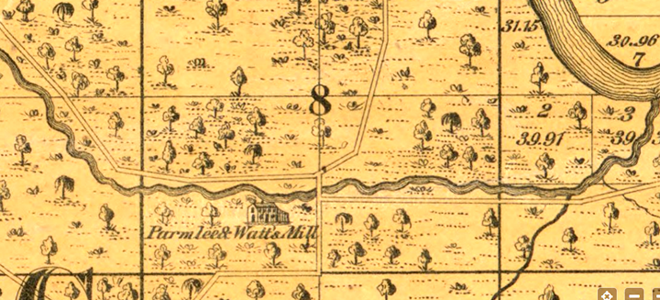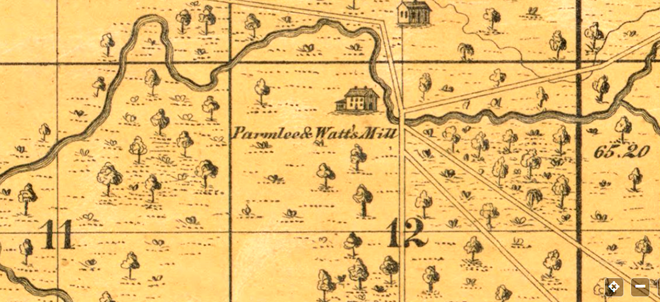|
Mills Important Part of Warren County, by Bev Dickerson, (believed to be from the Indianola Herald Tribune, Indianola, IA, June 28, 2006), article at the Warren County Historical Society Library
Parmelee Mill 1843-1871
One of the old mills that played an important part in the early settlement of Polk, Warren, Madison, Dallas and Boone Counties was the Parmelee Mill, erected on Middle River in 1843 on a site that was later in Polk County and is now in Warren County. John D. Parmelee, founder of the mill and one of the first settlersin that vicinity, was a native of Vermont who found the valley of Des Moines much to his liking. He referred to that region as the flower of Iowa and the garden of the world. If he could have his friends on the banks of the lovely Des Moines [River], he declared, he would bid a long adieu to old Vermont. When Parmelee arrived, the nearest mill was at Oskaloosa, 50 miles away, so he set out to provide milling facilities. First he built a sawmill, which supplied the lumber for the barracks at Fort Des Moines. In 1847 the first run of burrs was added for the grinding of corn. There was no wheat in this region, it is said, until the harvest of 1848. When the gristmill was completed, it was a three-story frame structure, 45 by 35 feet in dimension, as fine a building, Parmelee said, as any of its size in Vermont. At first the mill was overworked and was frequently out of order. Sometimes the settlers had to help repair it before their grinding or sawing could be done. Moreover, for the operation, management and repair of the mill, Parmelee was not always available. Although a good miller in many respects, he was unfortunate in his association with alcohol, and his milling interests were then neglected. With the passing of the years other mills were established and the business of the Parmelee Mill subsided. It became a significant landmark but its importance diminished. In January 1850, the Fort Des Moines Gazette published a list of sawmills in that vicinity which included Parmelee's two mills on North River. On April 12, 1871, the Parmelee Mill located on the Major Suder place was destroyed by fire. It was then owned by B. F. Allen of Des Moines. The second mill was call the Parmelee and Watts Mill.
John Watts
When Mills Played an Important Part in Warren County, by Edith L. Conn (date unknown, booklet at the Warren County Historical Society Library)
The obituary of John Watts found in Indianola newspapers in March 1897 tells us much of the milling business of the Parmalee & Watts Mill. John Watts was born in Northumberland County, Pennsylvania on July 23, 1819. Here he grew up and learned the millwright trade and followed the trade in the state of his birth. He came to Iowa in the fall of 1848. He spent the winter in Des Moines. In the spring he built the Summerset mill on Middle River, crossing North River somewhere between where Carlise is now situated and the Indianola-Des Moines road, with a one-horse vehicle in a canoe as a ferry boat. In the spring of 1851 he went into partnership with John D. Parmalee in milling, farming and general merchandise business at the old government mill on Middle River, two miles east of Carlisle. This business contined until the financial crisis of 1857-1859, when with others, they met with total failure. He then helped run the Middle River Mill, which his brother, William Watts had purchased from M. T. Taylor of Baltimore, MD., who was a creditor of the firm of Parmalee and Watts. |

